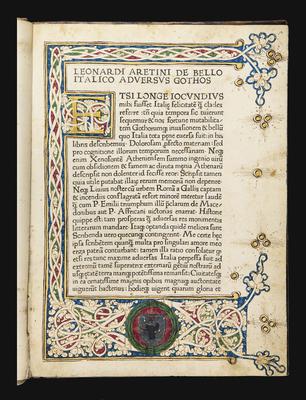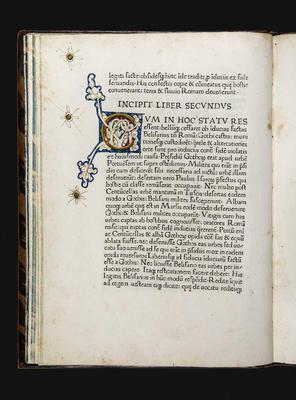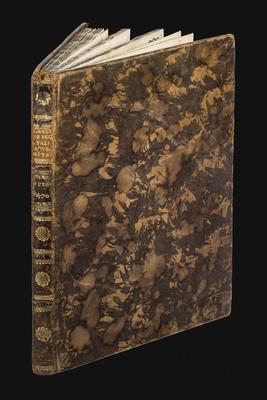Leonardus Brunus Aretinus
De bello italico adversus Gothos gesto.
Foligno, Johann Neumeister and Aemilianus de Orfinis, 1470.Folio (283x206 mm). Collation: [a12, b-f10, g12]. [73] of [74] leaves, wanting the last blank. Text in one column, 29 lines. Type: 1:124R. Seventeenth-century inked foliation on the upper outer corner. On fol. [a]2r within a gold burnished frame white vinestem three-side border on green, blue and crimson ground, including a six-line illuminated initial ‘E' in gold; on the lower panel the coat of arms of the Bufalini family within a laurel wreath(on silver ground a bull's head surmounted by a red flower). Four illuminated initials on similar vinestem ground with marginal extensions; one smaller initial on fol. [a]3r. Handsome seventeenth-century mottled calf. Smooth spine, gilt tooled and divided in compartments by fillets and friezes. Title and imprint on double lettering-pieces. Pastedowns in floral design paper. Marbled blue edges. A beautiful copy on thick paper with the original illumination, the last leaf backed. A few marginal notes in a seventeenth-century hand. On the verso of the front flyleaf an early shelfmark ‘C.II.X.3'.
Provenance: Bufalini family (coat of arms in the illuminated border on [a]2r); ‘a.r.s.' (small ex-libris on the front pastedown); Livio Ambrogio collection.
The exceedingly rare first book printed in Foligno (Umbria), the first edition of this work traditionally ascribed to the Florentine chancellor Leonardi Bruni, and the first appearance of the fine antiqua type designed and cut by the goldsmith Emiliano di Piermatteo degli Orfini for the German printer Johann Neumeister, who introduced printing into the city. One of only three books printed by the two men's partnership: the Epistolae ad familiares by Cicero followed in about 1471, and on 11 April 1472 Dante's Commedia was published. The De bello italico adversus Gothos gesto libriivis a narrative account of the barbarian invasions of Italy in the years 535-554; although Bruni claimed to be the author his role was actually limited to translating a work by the Byzantine historian Procopius of Caesarea, originally composed in Greek in the sixth century A.D.: this edition is therefore probably the first incidence of plagiarism in the history of printing, since Bruni omitted to mention Procopius as the author of the text. As shown by the coat of arms painted on the first leaf, the earliest recorded owner of this copy was a member of the noble Bufalini family, whose residence was in Città di Castello near Foligno. As archival sources attest, a now-lost fifteenth-century codex containing Bruni's Epistolae once belonged to the Bufalini family, a circumstance that might suggest that the hitherto unidentified manuscript used for this edition also belonged to the same family, and that the present finely illuminated volume might have been the presentation copy offered by the grateful printers to the munificent Bufalinis.
The colophon of this Foligno edition is known in at least five variants. In this copy the first line of the colophon contains the misprint ‘Eulginas' instead of ‘Fulginas'.




